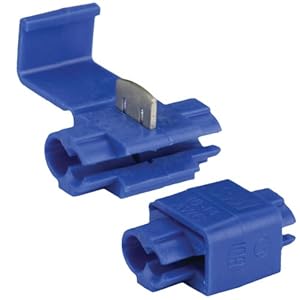Originally posted by squirrel
View Post
Announcement
Collapse
No announcement yet.
How to properly splice wires
Collapse
X
-
I'm more with Loren on his method, jam and solder. Of course, you don't want big lumps, buy long enough wire. Seriously, how long is your car?
That said, I like the nasa method, even on cars - it does work. It just requires a longer-then-average strip (not sure why Stairway to Heaven just popped into my mind, analysis will occur later), and gentle, opposite direction twists. Be sure to leave the heat-shrink on the outside for the first attempt, then get in a hurry on the second attempt and try to slide the heat-shrink over a still-hot solder (if you go quick, you'll be fine), on the 3rd time - it'll be a thing of beauty and a joy forever.Doing it all wrong since 1966
Comment
-
I've taken apart a few oem harnesses, mostly 60s-70s GM stuff. They usually have several big red wires spliced together, they connect the horn relay, battery connection, headlight switch, and ignition switch. They use a short strip, and a band crimped around all the wires, and then soldered. a couple wires in one side, a couple more in the other side. Not twisted.
Never seen a problem with them, either.
My fabulous web page
"If it don't go, chrome it!" --Stroker McGurk
Comment
-
compared to the squeezey pack whatever the hell you call those crush in line trailer light wire taps, solder is genius and permanent. That's what I have found myself repairing over the years, stuff that wasn't soldered. I'll take my chances with it damaging the copper. Flying south, with a flock of bird dogs.
Flying south, with a flock of bird dogs.
Comment
-
Originally posted by Beagle View Postcompared to the squeezey pack whatever the hell you call those crush in line trailer light wire taps, solder is genius and permanent. That's what I have found myself repairing over the years, stuff that wasn't soldered. I'll take my chances with it damaging the copper.

They are called Scotch Lock connectors. I agree, they suck for longevity. They are wonderful for the quick installation of, say, a trailer plug into a car (or truck) wiring harness by a u-haul shop or whatever... but like Beagle, I've had to cut apart and properly repair these old connections more than once.
As to the comment earlier about electricity / current in a twisted and soldered wire; once a wire is soldered like that joint, the current has more area to flow so it shouldn't get hot. It's like a wire nut in house wiring; the metal threads inside the wire nut make electrical contact in many locations, as well as pushing the wires themselves together firmly - so if done properly, the connection has sufficient current flow to not be a heat building resistance in the line.
Although I've made plenty of automotive splices with the inexpensive crimps they sell in every autoparts store across the country with pliers or vice grips, a splice done well with those crimps and a decent pair of crimping pliers will last for a long, long time - if heat shrink is used, even longer. No solder necessary.
These may not be the "correct" pliers for crimping, but it's what I use. Just fit the crimp into the correct size location, try to make sure the seam of the crimp is on the opposite side of the pokey part of the crimping tool, and crimp away.

Comment
-
Just make it clear that you never use wire nuts on automotive applications! We prefer one of three methods: solder joints and heat shrink, uninsulated crimp connectors and heat shrink, or crimp terminals with factory heat shrink insulation...Patrick & Tammy
- Long Haulin' 2008, 2009, 2010, 2011, 2012, 2014...Addicting isn't it...??
Comment
Comment